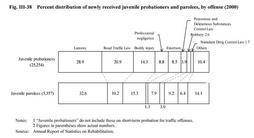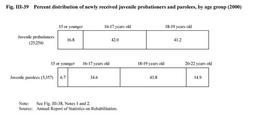| Previous Next Index Image Index Year Selection | |
|
|
3 Characteristics of juveniles on probationary supervision (1)Type of offense
Fig. III-38 shows the percent distribution of juvenile probationers (excluding those on short-term probation for traffic offenses;the same applies throughout in this segment)and parolees from juvenile training schools newly received by probation offices in 2000, by offense. (2)Age Fig. III-39 shows the number of newly received juvenile probationers and parolees in 2000, by age group. As for juvenile probationers, 16-17 year olds had the largest share, which was almost the same as that of 18-19 year olds. Also, the percentage of those who are 15 or younger shows an upward trend, and is 16.8% in 2000, an increase of 1.8 points from the previous year. Although 18-19 year olds also had the largest share in parolees from juvenile training schools, the percentage of those parolees who were 20 years and older increased to 14.9%. (3)Nationality By nationality (including regions), Japanese formed the highest share in juvenile probationers newly received in 2000 with 98.4%, followed by Koreans with 0.8%, Brazilians with 0.4%, Chinese with 0.2%, and others with 0.2%. As regards juvenile parolees, Japanese also formed the largest share by far with 98.0%, followed by Koreans with 1.0%, Brazilians with 0.5%, Philippine nationals, Chinese, and Vietnamese with 0.1% each, and others with 0.1% (Source:Annual Report of Statistics on Rehabilitation). Fig. III-38 Percent distribution of newly received juvenile probationers and parolees, by offense (2000) Fig. III-39 Percent distribution of newly received juvenile probationers and parolees, by age group (2000) (4)Previous record of protective measures By previous record of protective measures, the percentage of juveniles with no previous record was highest among juvenile probationers newly received in 2000, at 49.4%. This was followed by those on probation, at 18.6%, those who had been dismissed after a hearing, at 15.0%, and those who had been dismissed without a hearing, at 14.0%. Among juvenile parolees, those without any previous record only accounted for 25.6%. As regards parolees with previous records, former juvenile probationers had the largest share, at 40.0%, followed by those who had been committed to juvenile training schools, at 18.2%, those who had been dismissed after a hearing, at 6.8%, and those who had been dismissed without a hearing, at 6.1%. The percentage of those without previous record had been rising for both juvenile probationers and parolees until 1998, but slightly declined in both cases in 1999. Although the percentage of those without previous record has risen by 1.2 points from the previous year for juvenile probationers, it has declined by 0.9 points for juvenile parolees (Source:Annual Report of Statistics on Rehabilitation). (5)Drug use Among juvenile probationers newly received, the percentage using drugs at the time of reception has shown a downward trend recently. 14.9% were using drugs at the time of reception in 2000, a 1.3-point decline from the previous year. Organic solvents were used most frequently (12.2%), followed by stimulant drugs, at 2.3%. As regards juvenile parolees, 39.5% (39.8% in the previous year)were using drugs at the time of reception. By type of drug, organic solvents (26.9%) and stimulant drugs (11.4%) were used most commonly (Source:Annual Report of Statistics on Rehabilitation). (6)Relationship with delinquent groups 36.8% of juvenile probationers newly received in 2000 had relationships with delinquent groups at the time of reception. Bosozoku (motorcycle gang)were the most frequent group of association (16.5%), followed by local delinquent groups (12.9%), delinquent pupil/student groups (5.4%), and organized crime groups (0.7%). The percentage was as high as 62.6% for juvenile parolees, with frequent association with bosozoku (35.7%), local delinquent groups (17.9%) and organized crime groups (5.0%), in that order. Therefore, the percentage of the relationship with organized crime groups in particular was far higher than the cases of juvenile probationers (Source:Annual Report of Statistics on Rehabilitation). |

